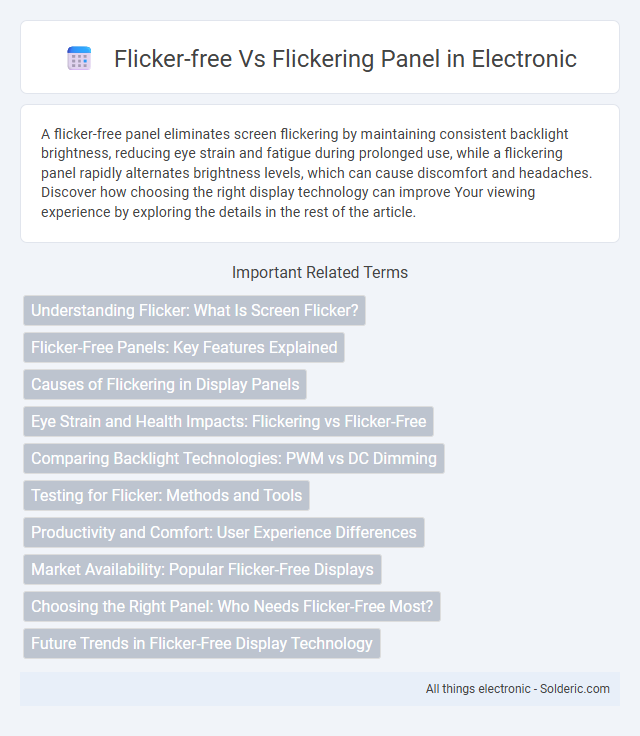A flicker-free panel eliminates screen flickering by maintaining consistent backlight brightness, reducing eye strain and fatigue during prolonged use, while a flickering panel rapidly alternates brightness levels, which can cause discomfort and headaches. Discover how choosing the right display technology can improve Your viewing experience by exploring the details in the rest of the article.
Comparison Table
| Feature | Flicker-Free Panel | Flickering Panel |
|---|---|---|
| Definition | Displays without visible screen flicker, using DC or advanced backlight technology. | Exhibits screen flicker due to PWM backlight or unstable refresh rates. |
| Eye Strain | Reduces eye fatigue and headaches. | Causes increased eye strain, discomfort over time. |
| Backlight Technology | Uses DC dimming or flicker elimination methods. | Relies on PWM (Pulse Width Modulation) causing flicker. |
| Usage | Ideal for long-term computer use and sensitive users. | Less suitable for extended viewing periods. |
| Price Range | Usually higher due to advanced technology. | Generally lower cost, common in budget displays. |
Understanding Flicker: What Is Screen Flicker?
Screen flicker refers to the rapid and repeated change in brightness or color of a display panel, which often causes eye strain, headaches, and discomfort during prolonged use. Flicker-free panels use DC dimming technology to maintain consistent brightness without pulsating light, while flickering panels rely on PWM (Pulse Width Modulation) that rapidly turns the backlight on and off. Understanding flicker helps you choose a display that reduces visual fatigue and improves your overall viewing experience.
Flicker-Free Panels: Key Features Explained
Flicker-free panels eliminate screen flickering by using DC (direct current) dimming technology instead of PWM (pulse width modulation), reducing eye strain and fatigue during extended use. These panels maintain consistent brightness levels and stable backlighting, which improves visual comfort, especially in low light conditions. Flicker-free technology is essential for gamers, designers, and office workers who require prolonged screen time without adverse effects on eye health.
Causes of Flickering in Display Panels
Flickering in display panels is primarily caused by inconsistent backlight modulation, low refresh rates, or poor power supply regulation, leading to rapid light intensity changes that strain your eyes. Flicker-free panels utilize DC dimming or high-frequency PWM to maintain a steady light output, reducing eye fatigue and improving viewing comfort. Understanding these causes helps you select displays that minimize flicker, enhancing visual clarity and overall user experience.
Eye Strain and Health Impacts: Flickering vs Flicker-Free
Flicker-free panels significantly reduce eye strain by eliminating the rapid light fluctuations that cause discomfort and headaches during prolonged screen use. Flickering screens can lead to visual fatigue, increased risk of dry eyes, and even migraines, making flicker-free technology essential for users with sensitive eyes or extended screen time. Choosing flicker-free displays contributes to better overall eye health and reduces long-term risks associated with continuous exposure to screen flicker.
Comparing Backlight Technologies: PWM vs DC Dimming
PWM (Pulse Width Modulation) and DC dimming are two backlight technologies that impact flicker in displays differently. PWM controls brightness by rapidly turning the backlight on and off, which can cause flickering that may lead to eye strain or headaches during prolonged use. DC dimming reduces screen flicker by adjusting voltage to control brightness steadily, offering a more comfortable viewing experience, especially important for your eyes if you are sensitive to flicker or use screens for extended periods.
Testing for Flicker: Methods and Tools
Testing for flicker in display panels involves using specialized tools like oscilloscopes, photodiodes, and flicker meters to measure light modulation and frequency. Methods include analyzing pulse-width modulation (PWM) signals and recording luminance variations under different brightness settings. Accurate flicker detection ensures the identification of flicker-free panels, which provide stable, eye-friendly visual experiences compared to flickering displays.
Productivity and Comfort: User Experience Differences
Flicker-free panels significantly enhance productivity by reducing eye strain and visual fatigue during extended screen use, making them ideal for professionals and gamers requiring sustained focus. Flickering panels cause intermittent light fluctuations that can lead to headaches, blurred vision, and decreased concentration, negatively impacting overall comfort and efficiency. Choosing a flicker-free display improves user experience by promoting healthier visual ergonomics and enabling longer, more comfortable work sessions.
Market Availability: Popular Flicker-Free Displays
Flicker-free displays dominate the market in laptops, monitors, and smartphones, featuring technologies like DC dimming and PWM reduction to minimize eye strain and fatigue. Leading brands such as ASUS, Dell, and BenQ offer a wide range of flicker-free panels, catering to gamers, professionals, and general users demanding eye comfort during prolonged screen use. The increasing adoption of flicker-free technology reflects consumer preference for healthier viewing experiences in both home and office environments.
Choosing the Right Panel: Who Needs Flicker-Free Most?
Flicker-free panels are essential for users who spend extended hours in front of screens, such as graphic designers, video editors, and programmers, as they significantly reduce eye strain and fatigue caused by screen flickering. In contrast, flickering panels can lead to headaches, blurred vision, and discomfort during prolonged use, making them less suitable for professionals requiring precision and comfort. Selecting a flicker-free monitor enhances visual comfort and productivity, particularly for those sensitive to screen flicker or prone to migraines.
Future Trends in Flicker-Free Display Technology
Flicker-free display technology is evolving rapidly with advancements in OLED and mini-LED panels that reduce eye strain and improve visual comfort. Future trends emphasize integrating higher refresh rates and DC dimming techniques to eliminate flickering at all brightness levels. Ongoing developments in AI-driven adaptive brightness control further enhance flicker-free experiences for prolonged screen use.
Flicker-free vs Flickering panel Infographic

 solderic.com
solderic.com